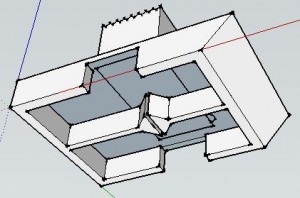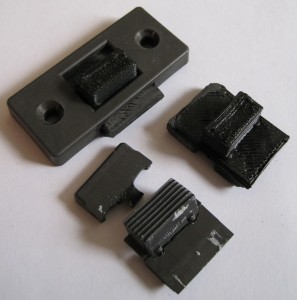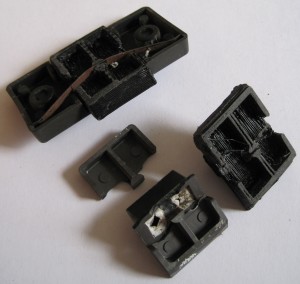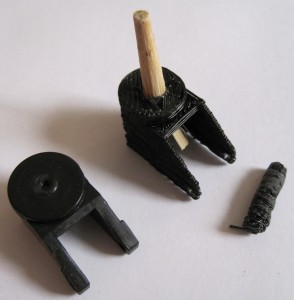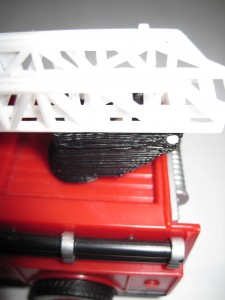I cannot take credit for these fantastic plugins. Since posting this originally I have heavily edited it to include all the great Google Sketchup plugins I’m using. 1 Without further ado they are:
- skp_to_dxf.zip (5829 downloads ) – This script will allow you to import STL and DXF. I haven’t used this one as much as the other two. I think this script was written by someone named Guitar-list.
- su2stl.zip (6898 downloads ) – This script will allow you to import/export STL files. I’ve had pretty good success exporting STL files, but the importing is very hit or miss. This Ruby script appears to be encrypted, so I don’t know who wrote it and I don’t know enough Ruby to decode it. This is the best link I could find to it.
- polyreduce.zip (5501 downloads ) – This script will reduce the number of polygons and faces in a Sketchup model. With really complex models (or an underpowered computer) it can take a LONG time to work. Fair warning. This great script was written by someone named Whaat.
- Update 7/11/2010: drawhelix13.zip (2056 downloads ) – Script for generating a helix. Super awesome for creating screw threads. 2 This script was written by someone named Peter Brown, but I cannot find any link to his site or contact information. Sorry Peter. I did find some instructions on how to use this plugin.
- Update 7/27/2010: manifold.zip (4217 downloads ) – Script for making a Sketchup object manifold. I’ve tried it a few times and found that it works slowly on my super under powered machine. I’ve gotten bored and stopped it before it has completed. That said, I’m quite confident a more patient person could get it to work no problem. :) Manifold was written by someone named TIG who is a prolific creator of Sketchup plugins/Ruby scripts on the Sketchucation forums. I found this plugin thanks to the Capolight blog – there’s some amazing stuff over there – check it out.
- Update 11/25/2010: jf_stl_importer.zip (4393 downloads ) – Script for importing STL files by Jim of Jim’s Sketchup Plugins.
- Update 11/25/2010: RoundCorner-2.1c.zip (8582 downloads ) – Script for adding rounded or beveled corners to objects. This plugin by Fredo6 has some detailed installation and usage instructions on the Sketchup Forums pages. He’s also included instructions as a PDF – Quickcard-RoundCorner-English-v2.1.pdf (812 downloads ) . This plugin requires Fredo6’s shared code library called LibFredo6-3.4c.zip (1085 downloads ) with it’s own LibFredo6-User-Manual-English-v3.4-14-Sep-09.pdf (746 downloads ) .
- Update 11/25/2010: FredoScale-2.0i.zip (850 downloads ) – Script for manipulating objects, also by Fredo6 with detailed instructions on the Sketchup Forums. Also with detailed instructions as a PDF – FredoScale-User-Manual-English-v2.0-28-Mar-09.pdf (685 downloads ) . There are also tutorial videos here and here. This plugin requires Fredo6’s shared code library called LibFredo6-3.4c.zip (1085 downloads ) with it’s own LibFredo6-User-Manual-English-v3.4-14-Sep-09.pdf (746 downloads ) .
- Update 11/25/2010: Curviloft-1.0c-and-LibFredo6-3.5c.zip (1033 downloads ) – Script for creating curved surfaces or skins from contours or paths, also by Fredo6 with detailed instructions on the Sketchup Forums. Although there isn’t any documentation, there are two tutorial videos here and here with an additional tutorial here. This plugin requires Fredo6’s shared code library called LibFredo6-3.4c.zip (1085 downloads ) with it’s own LibFredo6-User-Manual-English-v3.4-14-Sep-09.pdf (746 downloads ) .
- Update 11/25/2010: tt_solid_inspector.zip (3938 downloads ) – Script for detecting problems with solid forms by Thomas Thomassen.
- Update 12/27/2010: wafer.rb (3782 downloads ) – Script for converting a Sketchup file into Gcode for cutting 2D shapes using a CNC machine. I can’t find the name of the author, but this is his website with instructions for how to use his plugin.

